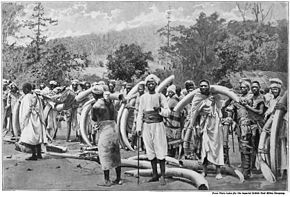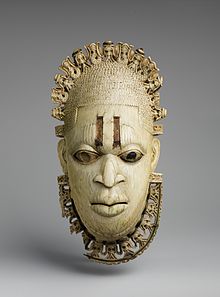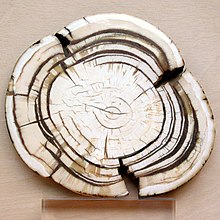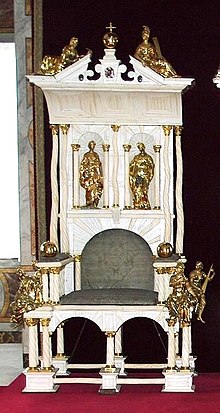ivory
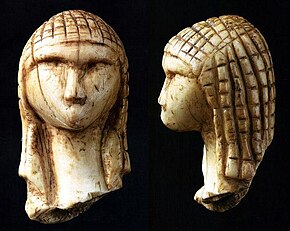
Ivory in a narrower sense denotes the substance of the tusks of elephants and mammoths , with the killed elephant nowadays being the main source of ivory, while the extinct mammoth provides the fossil ivory. In a broader sense, ivory is also understood to mean the dentin of the tusks and canines of various mammals, such as walrus , sperm whale , narwhal or hippopotamus .
Ivory is a popular material for the production of everyday objects and jewelry. The increasing demands of a growing world population have resulted in the number of elephants being greatly reduced, so that the population of the African elephant in particular is endangered.
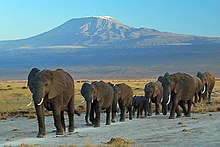

Etymology and Definition
The German word ivory ( Middle High German hëlfenbein , Old High German helfantbein ) means elephant bone . It goes back to the ancient Greek ἐλέφας ( éléphas ) and the Latin elephantus , which initially referred to the material and was later transferred to the animal when the Greeks and Romans got to know it. In ancient Rome it was used to make dentures . Here it was also called the Indian horn , as can be seen in the epigrams of Martial .
Historically, ivory has usually only been related to the tusk material of elephants and mammoths. Accordingly, art history and the antique trade distinguish this from other dental material. In species protection law, this term also refers to the tusks of the elephants, here a distinction is made between “raw ivory” and “processed ivory”.
Ivory from the elephant
overview
During the longest period in human history , the Stone Age , hunting was used solely for food. The indigestible parts ( skins , hides , horn , bones , ivory ) were recycled. A change occurred with the emergence of agriculture and animal husbandry and the emergence of advanced cultures , especially in the Afro-Asian region. Ivory became part of these cultures and the elephant hunt began for ivory alone. The elephant's ability to defend itself and the dangers of hunting made ivory a valuable raw material that later found its way into the cultures of the Greeks and Romans. The rarity of the material for more than 2000 years secured ivory a similar appreciation as gold.
A first momentous change was prepared with the takeover of the ivory trade by the colonial powers England , the Netherlands and Portugal , which caused an oversupply. At the end of the 19th century, over 800 tons of ivory were imported into Europe annually, which contributed to the cheaper ivory and to industrial processing (handles of all kinds, piano keys, vessels, jewelry, buttons, dice, dominoes, billiard balls). Projections from 1894 spoke of 80,000 animals killed per year.
The second, far more serious development in the now enormously decimated elephant population concerns the present. It is estimated that the population fell from 1.3 million to 500,000 to 700,000 in just 30 years (1979–2007). The reason is the constantly increasing demand from the souvenir trade and the prosperous middle classes of the emerging peoples of Asia. Ivory items are valued as status symbols . International animal welfare and environmental organizations have made it their business to bring about a rethink here or to counteract the poaching of elephants.
Description of the material
Ivory is the dentin of the tusks growing out of the upper jaw. Since these are not used to chop up food, neither tooth enamel nor tooth roots are present. Tusks are hollow on the inside (with a solid tip) and elastic to some extent. They serve as a weapon that grows back steadily throughout life.
The elephant's ivory is a relatively soft material that can be easily worked with cutting tools (see article Ivory Carving ). The color is a warm white with gradations, color deviations are rare. Evenly light ivory is considered particularly valuable.
The hardness of ivory on the Mohs scale , which ranges from 1 to 10, is given in the literature as 2 to 3, which makes it about the hardness of gold. The fluctuations result from the food supply. The more minerals the elephant ingests, the harder its tusk is. The density is 1.7 to 1.85 g / cm³ and is thus between the values of bone and lightweight concrete . Ivory is made up of: calcium phosphate, calcium carbonate, water, aluminum oxide, magnesium oxide, gelatin and albumin. The connecting substance is a cartilage-like organic mass in which water is stored. Ivory loses around 20% of its weight when it dries. The drying process must be carried out gently in order to avoid cracking. Ivory becomes pliable and can be deformed by boiling water. It can be dyed and bleached, but does not lose its tendency to yellow.
With the naked eye - in contrast to the bone substance - a reticulated drawing (Retzius or Schreger lines) can be seen in the cross-section, also known colloquially as grain. The different angles of intersection of the intersecting lines allow an assignment according to animal species. Under the microscope and using spectroscopic methods, a distinction can be made between Asian elephants , African steppe elephants , African forest elephants and mammoths . High-resolution X-ray computer tomography (HRXCT) has also recently been used. These non-destructive examination methods serve to identify and determine the origin of ivory and are therefore the basis for customs measures (see section ivory and species protection ).
Another - albeit more expensive - method is DNA analysis, which is not suitable for antiques due to the system-related material extraction. A more precise local origin can even be determined using DNA analysis.
use
Because of its rarity and beauty, ivory has long been one of the precious raw materials , which in all cultures was considered a noble material for artfully crafted objects with court , cult or religious purposes. In addition, it was also used in the secular area at all times.
Today ivory has been of practically no importance as a raw material in Europe for decades. Inexpensive plastics are used for the production of everyday objects , which serve better in all areas. In crafts has long been on ivory waived. The exception is the restoration of antique pieces, for which material from legal old stocks can be used. The main raw material used by today's ivory carvers is fossil mammoth ivory. There are no trade bans for this.
In contrast, elephant ivory, with an estimated black market price of 2,200 euros per kilogram (2013), is considered a prestigious material for luxury items , especially in China, such as a luxury car clad in ivory on the inside and outside.
Ivory trade
General
The ivory trade is part of the unprecedented plundering of an entire continent, where man was once made a commodity ( slave trade ). The race for Africa , which was once sparked by the European colonial powers and is still going on today with other participants, is seen, among other things, as the cause of the destabilization in some regions and the growing number of failed states . A lack of or damaged state order promotes overexploitation and, in the case of ivory, rampant poaching . The uncontrolled exploitation largely prevented the development of a sustainable economy and shifted added value to other parts of the world.
The ivory trade was in the hands of African and Arab merchants for centuries . Archaic hunting methods ( bow and arrow , spear , pitfalls ) and the difficulties of transport (columns of carriers, dugouts ) prevented overhunting and set natural limits to the volume of trade. That changed with the arrival of the Europeans and their technological lead in shipbuilding ( caravel ) and in weapons technology ( firearms ). The first restrained and peaceful steps were soon followed by colonization , proselytizing , taking over the trade and relocating the trading centers. The main trading centers for ivory were Amsterdam and London . They only lost this status to places in East Asia during the Second World War , especially to the British crown colony of Hong Kong at the time .
Legal trade
During the period when Europeans - mainly Great Britain - dominated the ivory trade, the concept of poaching and illegal trade did not exist. Everything that the colonial powers did in the context of their enrichment-based ventures was considered legal, especially overhunting with the severe depletion of elephant populations in the 19th century. Only with the obvious decline of the elephants and the increasingly younger hunting prey - recognizable by the smaller tusks - did a rethink begin.
According to the Washington Convention on the Conservation of Species (CITES), which 179 of the 193 member states of the United Nations have signed (as of 2013), trade in ivory is restricted. It is legal to trade in ivory antiques that were manufactured before June 1, 1947, which must be certified by a publicly recognized expert for species protection. There are also exceptions for individual states. In Thailand , the trade in ivory is permitted, which comes from its own 4,000 Asian breeding elephants. The ivory trade (since 1999) in the four South African states of Namibia , Botswana , Zimbabwe and the Republic of South Africa is also permitted under certain conditions , because their elephant populations are considered stabilized.
These four countries were allowed to auction a total of 151 tons of ivory to traders from Japan and China in 1999 and 2008 . Species conservation organizations had warned against these sales because they feared that poached ivory could be smuggled into the market in this way, which, according to observers, was actually the case.
Illegal trafficking
The illegal trade is kept going by the high demand and smuggling of poached ivory. Contraband goods that have not been detected by customs and that reach the recipient can forbidden be declared as legal ivory and traded and processed within the recipient country. International agreements have no effect here. Hong Kong is the main trading center for illegal ivory. The total volume of the black market can only be estimated. It is believed that customs authorities only discover about one in ten deliveries.
Problem
The control of the generally applicable ivory trade ban is made difficult or impossible due to various circumstances. There are major formal obstacles in the fact that not all states have signed the Convention on the Protection of Species and that there are no means of enforcing the Convention. Practice also shows the helplessness in the face of corruption that is widespread at all levels . In trade, it is virtually impossible to distinguish between legal and illegal ivory.
poaching
The term poaching comes from the hunting law of the European states. In the course of European expansion ( colonialism ), these norms were also imposed on peoples with a fundamentally different approach to hunting and archaic hunting methods, to whom the facts of poaching were alien. Europeans considered themselves hunting masters in large parts of the world, with wild animals considered ownerless and allowed to be shot for pleasure. British governors in India even offered rewards. Until well into the 20th century, big game hunting was a socially recognized event that hardly required a permit. However, high costs for equipment and logistics prevented the harmful development of popular sports .
Only the end of colonialism after the Second World War and the formation of independent states brought the turning point here. In place of lawlessness and chaos or national regulations, more and more agreements between the community of states and an international ban on poaching have taken place.
The measures implemented so far could not prevent the increasing demand for ivory from being met mainly through poaching and smuggling . It is estimated that around 38,000 elephants are poached each year in Africa. A threatening development in parts of Africa that has been observed for years is the activities of the various rebel and terrorist groups, who are heavily armed as poachers and are financed from the ivory business.
Ivory and conservation
The protection of species , that is, the preservation of biodiversity , can be served in different ways. The oldest and best-known measure is the establishment of protected areas . To enforce the concept of protection, rangers are used who were initially unarmed or who had light police weapons for self-defense. However, since poachers are now organized in gangs and are heavily armed, the emergency services were equipped with assault rifles and other automatic weapons. Helicopters , surveillance drones and bloodhounds represent an increase in the fight against poaching .
Since the vastness of the areas to be monitored often only allows for incidental successes, efforts on the ground include measures against smuggling at the borders. These include above all the customs controls in seaports and airports , both in the countries of origin and in the recipient countries - sometimes with the help of sniffer dogs . The steady growth of bonded warehouses and the fear of theft have led the world to believe that confiscated ivory must be finally withdrawn from circulation.
The media-effective, i.e. public destruction of illegal ivory is considered to be the clear zero tolerance signal against poaching and smuggling. Since 1989, around 180 tons of smuggled ivory have been destroyed in spectacular operations. It all started with Kenya , which burned 12 tons. Other African countries ( Zambia 10 tons, Gabon 5 tons) followed suit. In 2011 Kenya again gave almost 5 tons of ivory to the flames. The largest amount of ivory to date (105 tons) was burned by Kenya on April 30, 2016. By 2016, the following countries had destroyed their seized ivory stocks: Philippines 5 tons, USA 6 tons, China 6 tons, France 3 tons, Dubai 18 tons (1992 and 2015), Congo 5 tons.
In 2008, 17 African states signed the Bamako Elephant Declaration to end the trade in confiscated ivory permitted in the Washington Convention on Endangered Species.
Research conducted by IFAW and WWF in China has found popular belief that elephant tusks are shed from living animals , similar to antlers . With educational work, the species protection organizations hope to set a similar development in motion in China as in Japan 30 years earlier. At the time, Japan was the world leader in ivory consumption with 470 tons per year. Today's consumption is no more than a tenth.
Independently of this, the Chinese government announced that it would implement the resolution of the CITES conference on the protection of species from October 2016 and stop the trade in ivory and its products. After a twelve-month transition period, a general trade ban came into force on December 31, 2017.
Ivory from the mammoth

Stone Age figures made of mammoth ivory are considered to be the earliest evidence of human art (see section on the art history of ivory ).
After the last mammoths became extinct about 4,000 years ago, the tusks are only found in fossil form. They come mainly from the northern part of Siberia , where they are excavated during the arctic summer when the permafrost thaws and releases the treasures. Systematic extraction is not possible due to the size of the land. A sometimes dangerous search is carried out on the cliffs of the polar seas, where tusks are exposed by earth collapses. Mammoth ivory is also found in Canada and Alaska .
Mammoth ivory is a fascinating and unique raw material because it comes from a long-forgotten era in human history. With its discoloration, it is particularly used in modern jewelry production.
The color palette ranges from beige to dark brown, from blue to green in all nuances, to black. Tusks take on the colors of the minerals they are exposed to in the earth. The three trade classes are based on the degree of weathering of the tusks. The yield from well-preserved finds (commercial class A) is relatively high, since mammoth tusks are solid throughout. Mammoth ivory has a density of 2 to 2.2 g / cm³ and is about a fifth heavier than elephant ivory. The quality of the carving is about the same. The hardness is mostly 2.75–3.5 on the Mohs scale and corresponds to the hardness of gold.
The trade in mammoth ivory has been documented for centuries. It was delivered to China in the early imperial times and the ancient Greeks also knew it, as Theophrast reported. Even today (2014) China is the largest importer.
As long as elephant ivory was freely available, the ice age ivory did not have a large market due to the cracks and discoloration. Russia exported only 20 tons per year around 1900. Demand only rose when the elephant ivory trade bans came into effect. Since then, Siberian ivory has been exported to around 60 tons a year. Trading is not subject to any restrictions.
Ivory from other animals
In the Middle Ages, the narwhal's tusk was considered to be the most precious material because of its rarity and its mysterious origin, and at times it was worth ten times the value of gold . He fired the imagination and was taken for the healing horn of the legendary unicorn (see detailed description in the article Ainkhürn ). The narwhal's tusks, twisted like a spiral, ended up in the collections of rarities in European courts , mostly undivided as marveled pieces . Individual teeth were also made into insignia for secular and spiritual rulers ( scepter , crosier , throne ).
The ivory of the walrus canines, which grow back throughout their life and reach a length of 50 centimeters and more, is also valuable . The intensive hunting since the 16th century led to severe decimation or area-wise extermination. According to the Washington Convention on the Conservation of Species of 1973, walruses are only allowed to hunt and exploit the arctic coastal peoples, who have been relinquishing their licenses to hobby hunters for some years now. Handicrafts made from walrus ivory have a long tradition and go back around 2000 years (see also article Scrimshaw ). Harpoon tips were also made from walrus ivory .
The approximately 30 centimeter long canine teeth of the hippopotamus provide an ivory that never turns yellow . In the past, they were mainly used to make artificial teeth. The hippos, also known as hippos , which formerly lived on the Nile , were already extinct at the beginning of the 19th century.
Art history of ivory


As early as the Stone Age , people made everyday objects ( needles , spearheads ) and small sculptures from ivory . The oldest works of art found so far are sculptures made of mammoth ivory, such as Venus vom Hohlefels , the lion man , which is believed to be over 40,000 years old.
From Egypt there are grave goods made of ivory from 4000 BC. Known ( Badari culture ).
Finds from the Bronze Age were recovered in Mesopotamia and Syria , mostly using the canines and incisors of hippos . Carvings and relief work that were used as inlays in wooden objects or furniture could be secured at several sites such as Qatna , Ebla , Ugarit , Alalach .
With the rise of the Phoenicians to an important trading power in the Mediterranean (from 1000 BC), the coveted ivory work by Phoenician artisans came to many countries in Europe and the Middle East. After the elephants, which were also native to Syria at the time, were exterminated, the raw material was brought in from the interior of Africa on the Trans-Saharan caravan routes . The most famous Semitic ivory work is the throne of Solomon described in the Old Testament .
Ivory found a unique use in the design of the Zeus statue in Olympia , one of the Seven Wonders of the World , which the Greek sculptor Phidias made about 430 BC. Created. The approximately twelve meter high colossal statue is no longer preserved. The statue of Athena for the Parthenon in Athens , made in the same chryselephantine technique, also came from Phidias (replica see photo on the right). Gold and ivory sculptures have also come down to us from archaic Greece (photo left).
Among the Romans, ivory was very popular as a material for jewelry, small art, musical instruments, inlays and furniture decorations. During the imperial era , ivory was preferred by the consular diptychs .
With Christianity, ivory experienced an increase in importance towards the epitome of purity and became the ideal material for sacred objects (containers for hosts and relics , crucifixes , triptychs , bishop's staffs , book covers for the holy scriptures). The art of ivory continued through the Carolingians and Ottonians with their monastery workshops ( Lorsch , St. Gallen , Reichenau , Echternach ) and was widespread in the Christian West in the 11th and 12th centuries . Oriental carvings also found their way into Europe and into sacred use through the crusaders .
Holy water container, Byzantine, 9th century
Harbaville Triptych , Byzantine, 10th C.
Diptych , France, 14th century
During the Gothic period , ivory carvings were increasingly made for secular use, with French and Venetian workshops taking the lead. There was a break in the ivory tradition in the subsequent Renaissance , when other materials were preferred. Ivory carving really flourished in the 17th century, when German princes competed with each other to employ famous artists or even try themselves as ivory carvers. The many masterfully crafted pieces in the court collections date from this Baroque period.

The artistic standstill began with the advance of machines and the new machining options (Passig lathe). This went hand in hand with the increased use of ivory for consumer goods of all kinds. The ivory art experienced a final glow as a small sculpture in Art Nouveau and in the Art Deco period , especially in the gold-ivory technique ( chryselephantine ).
The German center of ivory carving was and is Erbach im Odenwald , where the German Ivory Museum was opened in 1966 . The ivory processing there was founded in 1783 by Franz I , the last ruling Count of Erbach (1754–1823), after which many artists settled in the town.
Ivory substitutes

In consumer goods , plastics , in particular dimensionally stable synthetic resins , have completely replaced ivory. The reasons for this are the easy availability of the starting materials with their low price and the properties of the plastics, which must be determined depending on the requirements. This makes them superior to ivory in all areas of application.
To artificially produce ivory, quicklime is extinguished with the calculated amount of water, but before the last amount of water is added the amount of phosphoric acid necessary for the formation of tribasic phosphoric acid lime is added. While stirring constantly, calcium carbonate, magnesium oxide, aluminum oxide and gelatine and albumin dissolved in water are added in the following proportions:
| Caustic lime | 100 | Th. |
| Distilled water | 300 | " |
| Phosphoric acid (1.05 to 1.07 spec. Wt.) | 75 | " |
| Calcium carbonate | 16 | " |
| magnesia | 1-2 | " |
| Aluminum oxide | 5 | " |
| gelatin | 15th | " |
This mixture should be stirred vigorously and then left to stand for some time.
After the mass has set, it is brought into molds and kept at a temperature of 15 to 20 °. This is followed by heating in an oven at 150 to 200 ° for 1 to 2 hours and, after allowing the mass to rest for 3 to 4 weeks, an artificial ivory is obtained, which is very similar to the natural one.
If one wants to give the ivory a higher specific weight, one replaces the carbonate of lime with barite ; if the volume is to be increased, zinc oxide or zinc sulfate is used. To make the artificial ivory more plastic and elastic, it is necessary to add cellulose or certain oils ( turpentine oil , castor oil , etc.) or shellac . It is best to use aniline, alizarin , campêche and brazil wood for dyeing .
For example, billiard balls made of synthetic resin have greater durability and better rolling properties. Among the substances have replaced the ivory, also includes porcelain , especially the artistically designed manufactured goods from bisque , the mid-18th century was invented.
Since the mid-19th century, the corozo has been a popular substitute for ivory for about 100 years. The corozo (ivory nut) is the seed of the corozo (ivory palm ) of South America. After months of drying, the corozo gets the hardness of bones. It has the color of very light ivory and like this it can be edited and colored as desired. The return to natural products and sustainability that began in the mid-1960s led to the rediscovery of the corozo. Sculptures, game pieces, chess pieces, buttons and much more are made from it.
See also
literature
- Federal Agency for Nature Conservation (BfN): Ivory and Species Conservation. Proceedings of INCENTIVS - Meetings (2004–2007), BfN-Skripte 228.
- Martin Dambach: The ball in ivory - a curiosity from the natural history cabinet. In: Naturwissenschaftliche Rundschau. Volume 62, No. 9, 2009, pp. 457-459.
- Detlef Groneborn: Gold slaves ivory - Medieval empires in northern Nigeria. Mainz 2011, ISBN 978-3-88467-177-1 .
- Heinrich Adolph Meyer : Ivory. Hamburg 1889.
- Raman Sukumar: The Living Elephants, Evolutionary Ecology, Behavior and Conservation. Oxford University Press, New York 2003, ISBN 0-19-510778-0 .
Art history:
- Otto Pelka: ivory. Berlin 1923.
- Eugen von Philippovich : ivory. A guide for collectors and enthusiasts. 1982.
items
- Reinhard Künkel: Elephants: Giants in need. In: Geo-Magazin. 1, (Hamburg) 1980, pp. 100–116: informative experience report: "Poachers who are keen on ivory ...."
Web links
- German Ivory Museum Erbach .
- Center for Ivory Research at the University of Mainz .
- Ban the Ivory Trade. Join the stove. Video on ivory trade and elephants.
- UNESCO World Heritage in the Museum of the University of Tübingen MUT: Press information, photos and 3D animations of the objects on unimuseum.de, Eberhard Karls University of Tübingen, Museum of the University of Tübingen MUT.
Individual evidence
- ^ Walter Hoffmann-Axthelm: The history of dentistry. Quintessenz, 1985, ISBN 978-3-87652-160-2 , p. 285.
- ↑ so with Krünitz
- ↑ Communication from the Commission - Guide - EU rules for ivory trade within the EU and for the re-export of ivory C / 2017/3106 . In: Official Journal of the European Union . C, Volume 154, May 17, 2017, pp. 4-14.
- ^ A b Meyers Konversations-Lexikon. Volume 5, Bibliographisches Institut, Leipzig and Vienna 1894, p. 685.
- ^ Meyers Konversations-Lexikon. Volume 5, Bibliographisches Institut, Leipzig and Vienna 1894, p. 612.
- ↑ Vanishing Elephants. National Geographic, accessed February 5, 2014 .
- ^ Brockhaus Encyclopedia: Volume 6, Verlag FA Brockhaus, Mannheim 1988, ISBN 3-7653-1106-5 , p. 304.
- ^ A. Banerjee, G. Bortolaso, W. Dindorf: Distinction between African and Asian Ivory . In: Federal Agency for Nature Conservation (Ed.): Ivory and Species Protection INCENTIVS - Conference Contributions for the Years (2004–2007) . Mainz 2008, p. 37-50 ( bfn.de [PDF]).
- ↑ A. Cutler, A. Götherström: African or Asian? DNA Analysis of Byzantine and Western Medieval Ivories . In: Federal Agency for Nature Conservation (Ed.): Ivory and Species Protection, INCENTIVS - Conference Contributions of the Years (2004–2007) . Mainz 2008, p. 73-80 ( bfn.de [PDF]).
- ↑ Kenine E. Comstock, Elaine A. Ostrander , Samuel K. Wasser: Amplifying Nuclear and Mitochondrial DNA from African Elephant Ivory: a Tool for Monitoring the Ivory Trade. In: Conservation Biology. 17, 2003, pp. 1-4.
- ^ Samuel K. Wasser, Andrew M. Shedlock, Kenine Comstock, Elaine A. Ostrander, Benezeth Mutayoba, Matthew Stephens: Assigning African elephant DNA to geographic region of origin: Applications to the ivory trade. In: Proceedings of the National Academy of Sciences . 101 (41), 2004, pp. 14847-14852, doi: 10.1073 / pnas.0403170101 .
- ↑ Luxury car with ivory motifs debuts in Guangzhou. In: german.china.org.cn. December 14, 2007, accessed February 19, 2015 .
- ^ Manfred KH Eggert: Retrospective. Archeology from a cultural-scientific point of view. Waxmann Verlag, Münster 2011, ISBN 978-3-8309-2493-7 , p. 156 ff.
- ↑ Raman Sukumar: The Living Elephants, Evolutionary Ecology, Behavior and Conservation. Oxford University Press, New York 2003, ISBN 0-19-510778-0 , p. 344.
- ^ Edward B. Barbier, Joanne C. Burgess, Timothy M. Swanson, Daniel W. Pearce: Elephants, Economics and Ivory. Earthscan Publications, London 1990, ISBN 1-85383-073-9 , p. 30.
- ↑ German Bundestag printed paper 16/13287: trade in ivory (accessed on 17 June 2011). (PDF; 76 KiB).
- ↑ Negative record for confiscated ivory. In: wwf.de. Retrieved February 19, 2015 .
- ↑ GF Michaelis: fight the wild animal speculators. In: Süddeutsche Zeitung. March 2, 2012, p. 18.
- ↑ Raman Sukumar: The Living Elephants, Evolutionary Ecology, Behavior and Conservation. Oxford University Press, New York 2003, ISBN 0-19-510778-0 , p. 88.
- ↑ Raman Sukumar: The Living Elephants, Evolutionary Ecology, Behavior and Conservation. Oxford University Press, New York 2003, ISBN 0-19-510778-0 , p. 78.
- ^ S. Wasser, B. Clark, C. Laurie: The Ivory Trail. In: Scientific American. 301 (1), 2009, pp. 68-74.
- ↑ Laura-Marie Rothe: Ivory trade finances rebels in Africa. In: dw.de. September 4, 2013, accessed February 19, 2015 .
- ↑ Wilhelma magazine. Edition 2, 2013, p. 26 f.
- ↑ Impact evaluation on ivory trade in China - IFAW - International Fund for Animal Welfare. In: ifaw.org. Retrieved February 19, 2015 .
- ↑ WWF measures against ivory trade in China. In: wwf.de. February 19, 2015, accessed February 19, 2015 .
- ^ Esmond Martin , Daniel Stiles: The Ivory Markets of East Asia. Published by Save the Elephants, Nairobi / London 2003, ISBN 9966-9683-3-4 , p. 13 ff.
- ↑ careforthewild.com ( Memento of the original from April 24, 2015 in the Internet Archive ) Info: The archive link was inserted automatically and has not yet been checked. Please check the original and archive link according to the instructions and then remove this notice.
- ^ Meyers Konversations-Lexikon. Volume 5, Bibliographisches Institut, Leipzig / Vienna 1894, p. 685.
- ↑ Hunting Worldwide: Hunting Worldwide - online - Service World Hunting Seasons Hunting for walruses in the Arctic. In: jww.de. Retrieved February 19, 2015 .
- ↑ Vogelherd Cave
- ↑ Art of the World. The non-European cultures. In: Irmgard Woldering: Egypt. Holle Verlag, Baden-Baden 1964, p. 17.
- ^ Luigi Turri: Ivory - prestige object of the elite. In: Appreciate Ancient Syria. The discovery of the Kingdom of Qatna. Stuttgart 2009, ISBN 978-3-8062-2272-2 , pp. 189-191.
- ^ Propylaea world history. Second volume, Propylaeen Verlag, Berlin / Frankfurt / Vienna 1962, p. 95.
- ↑ Brockhaus Encyclopedia. 17th volume, FA Brockhaus, Mannheim 1992, p. 112 f.
- ↑ Art of the World. The non-European cultures. In: Elsy Leuzinger: Africa. Holle Verlag, Baden-Baden 1964, p. 61.
- ↑ 1 Kings 10:18
- ↑ Anonymous: Artificial ivory. In: Polytechnisches Journal . 278, 1890, Miszelle 1, p. 42 f ..



